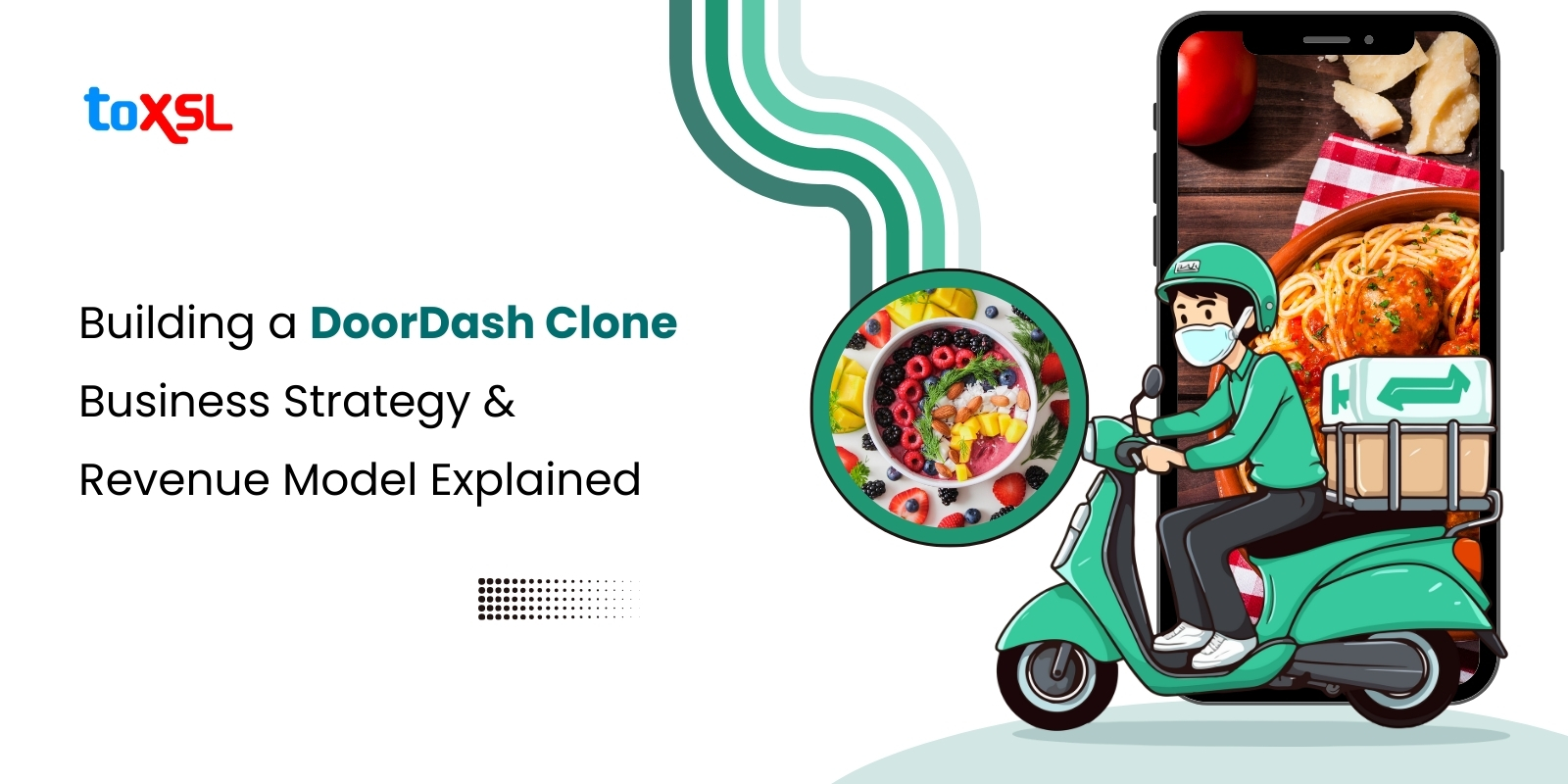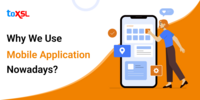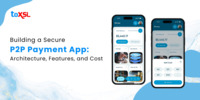- Oct 27, 2025
Share this post on:

A study conducted by Bloomberg Second Measure found that DoorDash has a market share of over 60% and approximately 42 million users in the US. According to Y Combinator, DoorDash experienced a 20% weekly growth rate in its first year of operations.
Over time, DoorDash has evolved into one of the most dominant players within the food delivery sector. It has revolutionized how customers order meals and how restaurants reach their customers. The food delivery market as a whole appears to be on a continuous growth trajectory. So, if you are a food business, developing an app like DoorDash can help you grow sales, reach more customers, and boost your restaurant’s online presence. This guide will explore the inner workings of DoorDash’s business model, its revenue streams, and how it sustains growth in a highly competitive landscape.
Key Takeaways
- DoorDash holds over 60% of the US food delivery market with a user base exceeding 42 million.
- The company’s revenue in Q2 2025 soared to $3.3 billion, representing a 25% year-over-year increase, signaling strong growth.
- Multiple revenue streams, including commissions, delivery fees, subscriptions, advertising, and SaaS offerings, power DoorDash’s robust business model.
- Developing an app like DoorDash involves complex technical and business considerations.
- The cost to develop a DoorDash clone app ranges between $80,000 and $100,000, depending on features and development scope.
DoorDash’s Business Model
DoorDash works on a marketplace model that connects three main stakeholders. They are: customers, merchants, and delivery drivers known as “Dashers”. This is a multi-sided platform that leverages technology, data, and logistics. This multi-sided platform leverages technology, data, and logistics to optimize the delivery experience, generating revenue through various streams. Here’s how it works in detail:
A) Revenue Streams
Commission Fees from Restaurants: DoorDash charges restaurants a commission fee on every order placed through its platform. This commission often ranges from 10% to 30%, depending on the partnership plan (Basic, Plus, Premier). For pickup orders, DoorDash charges a lower percentage commission of around 6%. This commission is critical, representing one of the largest revenue contributors.
Delivery Fees from Customers: Customers pay a delivery fee that varies based on order size, distance, demand, and location. While Dashers receive a significant portion of this fee as earnings, DoorDash retains part of it as profit. Delivery fees typically range between $5 and $8.
Subscription Service - DashPass: DashPass is DoorDash’s subscription model that provides users with benefits like free delivery and reduced service fees for a monthly fee of around $9.99. This not only drives recurring revenue for DoorDash but also encourages customer loyalty and higher order frequency.
Advertising and Promotions: DoorDash offers promotional services to restaurants and merchants who want to increase visibility on the platform, such as sponsored listings or targeted advertisements. This marketing service generates additional revenue.
Software-as-a-Service (SaaS) - DoorDash Storefront: This service helps restaurants create their own online ordering systems without commission fees. However, restaurants pay credit card processing fees per transaction and per order fees, contributing further to DoorDash’s income.
Expansion into Other Verticals: Beyond food delivery, DoorDash is growing into groceries, convenience stores, pet supplies, and alcohol. These expansions diversify revenue and increase market presence.
B) Operational Model
DoorDash’s logistics-as-a-service approach uses real-time algorithms to optimize delivery routes, dynamically assign orders to Dashers, and track deliveries. This technology-driven approach minimizes fixed costs by relying on independent contractors (Dashers) rather than full-time employees and allows rapid scaling.
C) Market Leadership
As of Q2 2025, DoorDash’s marketplace volume reached $24.2 billion, with order volumes hitting 761 million annually, growing 20% year-over-year. The company has solidified its place as the leader in the US food delivery market with over 60% market share, making it a model for similar platforms worldwide.
DoorDash’s Revenue Model
DoorDash's revenue model is built on multiple streams that monetize its platform by charging both customers and merchants while leveraging its logistics and marketing capabilities. Here is a detailed explanation of its main revenue sources as of 2025:
Delivery Fees: Customers pay a delivery fee for every order placed through DoorDash. This fee varies based on factors like distance between restaurant and delivery location, order size, and demand (surge pricing during peak times). While a portion of the delivery fee goes to the delivery driver (Dasher), DoorDash retains a share as revenue.
Service Fees: In addition to delivery fees, DoorDash charges a service fee, which is typically a percentage of the order total. This fee helps cover operational costs like platform maintenance, customer support, and payment processing.
Merchant Commissions: Restaurants and other merchants pay DoorDash a commission on each order fulfilled through the platform. The commission rates generally range from 15% to 30% of the order value, depending on the partnership plan (e.g., Basic, Plus, Premier). This revenue stream constitutes a significant portion of DoorDash's income.
DashPass Subscriptions: DoorDash offers a subscription service called DashPass, which provides customers unlimited free delivery and reduced service fees on orders from eligible restaurants for a monthly fee (around $9.99). This generates recurring revenue and encourages customer loyalty while increasing order frequency.
Advertising and Promotions: Merchants can pay for promoted listings, sponsored placements, and in-app advertising to increase their visibility on the platform. This additional marketing service helps restaurants drive sales and also adds to DoorDash’s revenue.
DoorDash Drive (White-Label Logistics): Through DoorDash Drive, businesses outside the DoorDash marketplace can use DoorDash’s logistics network for their own deliveries. This B2B service expands DoorDash’s revenue by offering delivery-as-a-service to other brands and enterprises.
Expansion into Grocery and Retail Delivery: Beyond restaurants, DoorDash partners with grocery stores, convenience shops, pharmacies, and alcohol retailers. These sectors generate revenue through delivery fees, commissions, and service charges similar to the food delivery model.
How to Develop a DoorDash Clone
1. Understand the Business Model
A DoorDash clone is essentially a food delivery platform connecting three groups:
- Customers: People who order food.
- Restaurants: Businesses providing food.
- Delivery Partners: Drivers delivering the food.
- Revenue comes from:
- Commission on each order (paid by restaurants)
- Delivery fees (paid by customers)
- Subscription plans for unlimited delivery or discounts
- Advertising/promotions for restaurants
- Understanding this model first is critical before development.
2. Market Research
- Before creating your app, you need to:
- Analyze competitors like DoorDash, Uber Eats, Grubhub.
- Find gaps in your target area (cities, cuisines, delivery speed).
- Understand what users want in a food delivery app.
- This ensures your app stands out and meets user needs.
3. Key Features of a DoorDash Clone
A successful DoorDash clone requires four main panels—Customer App, Restaurant App, Delivery Partner App, and Admin Panel. Each panel serves a specific purpose and ensures the ecosystem functions smoothly.
1. Customer App Features
The customer app is the most critical interface since it directly affects user experience and retention. Key features include:
Easy Registration & Login: Customers should be able to register quickly using email, phone numbers, or social media accounts. A simple onboarding process reduces friction and increases user adoption.
Search Restaurants by Cuisine, Ratings, Price: Users should be able to search for restaurants based on cuisine type, ratings, or price range. Filters like “fast delivery,” “offers,” or “popular” make the experience more personalized and convenient.
Real-Time Delivery Tracking: This feature allows users to track their orders in real-time, including pickup and delivery status. It builds trust and enhances transparency between the customer and the platform.
Secure Payments: Multiple payment options such as credit/debit cards, digital wallets, and UPI should be integrated. Secure payment gateways and encryption ensure user data safety.
Ratings & Reviews: Users can provide feedback for restaurants and delivery partners. Ratings and reviews help maintain service quality and guide future customers in their choices.
2. Restaurant App Features
The restaurant app helps food providers manage their operations efficiently while reaching a wider audience.
Dashboard to Manage Orders: Restaurants can view incoming orders, accept or reject them, and track order progress in real-time.
Update Menu Items: Restaurants can add, remove, or edit menu items, set prices, and manage item availability. This ensures accurate information is displayed to customers.
Promotions & Discounts: Restaurants can create offers, discount codes, or special promotions to attract new customers and encourage repeat orders.
Notifications for New Orders: Instant alerts for new, canceled, or delayed orders help restaurants manage operations smoothly without missing any orders.
3. Delivery Partner App Features
Delivery partners are crucial for timely and efficient delivery. Their app must support operational efficiency and ease of use.
Alerts for New Delivery Requests: Delivery partners receive instant notifications for new delivery tasks with customer details, pickup location, and estimated delivery time.
Route Optimization with GPS: The app should provide optimized routes to ensure faster deliveries. Integration with Google Maps or other navigation APIs helps avoid traffic and reduce delivery time.
Earnings Dashboard: Delivery partners can track their income, tips, and commission details. Transparency in earnings motivates them to stay active and maintain high-quality service.
Availability Toggle (Online/Offline): Drivers can toggle their availability to accept or pause delivery requests according to their convenience.
4. Admin Panel Features
The admin panel oversees the entire platform, ensuring smooth operations and quality control.
Manage Users, Restaurants, and Deliveries: Admins can add or remove users, approve or suspend restaurants, and monitor all delivery operations.
Track Analytics and Payments: Analytics tools provide insights into order trends, delivery times, revenue, and customer behavior. Payment tracking ensures accurate transactions and financial management.
Provide Customer Support: Admins handle complaints, refund requests, or queries from customers, restaurants, or delivery partners. Integration with chat or call support improves trust and user satisfaction.
4. Choose Technology
You need reliable tech to handle many users and real-time updates:
- Frontend (Apps): React Native or Flutter
- Backend: Node.js, Python, or Ruby on Rails
- Database: MySQL, MongoDB, PostgreSQL
- Cloud Hosting: AWS, Google Cloud
- Maps & GPS: Google Maps API
- Payment Gateway: Stripe, PayPal, Braintree
5. Design UI/UX
Keep it simple and intuitive.
Make order tracking real-time and visible.
Ensure easy navigation for all three user types.
6. Develop an MVP
Start with a Minimum Viable Product (MVP) containing only the core features.
Add advanced features later, like subscriptions, offers, or AI-based suggestions.
Make sure it works on iOS and Android.
7. Testing
Test internally (alpha testing)
Test with real users (beta testing)
Fix bugs and improve performance before launch
8. Launch & Marketing
Launch in a specific city or area first.
Use social media, referral programs, and partnerships with local restaurants.
Collect feedback and keep improving the app.
9. Maintenance & Scaling
Monitor performance and server uptime
Add new services like grocery or alcohol delivery
Improve delivery algorithms and customer support over time
Benefits of Developing an App Like DoorDash
Creating an app similar to DoorDash offers numerous significant advantages for businesses, entrepreneurs, and users alike, capitalizing on the booming on-demand food delivery market. These benefits not only help new ventures establish themselves but also assist existing food businesses and delivery services to scale, increase revenue, and enhance customer experience. Here are the key benefits in detail:
1. Access to a Larger Customer Base
An app like DoorDash dramatically extends the reach of restaurants and food service providers beyond their physical locations. Through such a digital platform, restaurants can tap into a vast audience of users who prefer ordering from the comfort of their homes or offices. This eliminates geographic constraints and opens doors to customers who might never visit the restaurant otherwise. By listing on a delivery app, even small or lesser-known eateries gain visibility on a popular platform, helping them attract new customers and boost sales.
2. Diverse and Recurring Revenue Streams
Developing a DoorDash-style app allows businesses to leverage multiple monetization options. These include commissions from partner restaurants on every order, delivery fees charged to customers, subscription programs such as DashPass that guarantee steady monthly income, and advertising opportunities for restaurants to increase their visibility. Having multiple revenue streams balances income sources, reduces risk, and creates a stable financial foundation for scaling the business.
3. Enhanced User Experience and Customer Convenience
An app like DoorDash provides a seamless and intuitive user interface for browsing menus, customizing orders, making secure payments, and tracking deliveries in real-time. The convenience of ordering anytime and anywhere encourages higher customer retention and loyalty. Features such as personalized recommendations, discounts, promo codes, and loyalty programs engage users and further enhance their experience. On-demand delivery apps significantly reduce wait times and eliminate common ordering hassles, leading to satisfied, repeat customers.
4. Operational Efficiency and Automation
These delivery platforms automate critical logistics and backend processes such as order management, delivery routing, driver dispatch, and payment handling. This automation reduces manual errors, speeds up order processing, and ensures clear communication among customers, restaurants, and delivery drivers. Restaurants can manage orders more efficiently through digital dashboards, update menus in real-time, and access performance analytics that assist with inventory and staffing decisions. Automating delivery operations helps optimize resources, lowers costs, and improves service speed.
5. Valuable Business Insights
Apps like DoorDash gather extensive data on customer behavior, order preferences, peak ordering times, and delivery performance. This data provides actionable insights that enable restaurants and platform operators to tailor marketing campaigns, optimize menus, and plan promotional offers strategically. Understanding customer patterns also guides inventory management and staff scheduling, reducing waste and improving profitability. Data-driven decisions help businesses stay agile and competitive in a fast-paced market.
6. Brand Building and Customer Loyalty
Having a dedicated branded app helps food businesses build a stronger digital presence and brand recognition. Push notifications, personalized offers, rewards programs, and in-app messaging facilitate continuous engagement, encouraging repeat orders and loyalty. A well-designed app keeps the brand top-of-mind for customers and reinforces positive associations, especially when combined with consistent prompt delivery and quality food.
7. Scalability and Market Expansion
A delivery app designed like DoorDash is highly scalable. Businesses can expand operations to new cities or regions without the need for additional physical infrastructure. They can also diversify offerings by adding new service categories such as grocery delivery, pharmaceuticals, or meal subscriptions. The platform can incorporate more restaurants and delivery partners as demand grows, making it adaptable to changing market trends and customer needs.
8. Competitive Advantage
The on-demand food delivery market is expected to continue growing rapidly worldwide. Having a robust app similar to DoorDash positions businesses to capitalize on this trend early, gaining competitive advantages through technology innovation and convenience. This is especially important as consumer expectations evolve, with increasing demand for contactless payments, sustainable delivery options, and curated food selections.
Cost to Develop an App Like DoorDash
Building a DoorDash-like app is a complex process that involves several development phases, technologies, and features. The cost varies widely depending on the scope, geographic location of developers, and feature complexity. The cost to develop an app like DoorDash ranges between $80,000 and $170,000. Here is detailed content on the cost to develop an app like DoorDash, along with a clear cost breakdown table:
Component | Estimated Cost (USD) | Description |
Discovery & Planning | $5,000 – $10,000 | Requirement analysis, market research, project scope |
UI/UX Design | $8,000 – $15,000 | User interface and experience design for app and dashboard |
Frontend Development | $15,000 – $30,000 | Apps for customers, delivery drivers, and restaurants |
Backend Development | $20,000 – $40,000 | Server, database, API, real-time order processing |
Restaurant Panel | $8,000 – $15,000 | Order management, menu edits, analytics for restaurants |
Delivery Agent Panel | $8,000 – $15,000 | Driver tracking, order acceptance, navigation |
Admin Dashboard | $10,000 – $20,000 | Platform monitoring, user management, payout setting |
API Integrations | $5,000 – $10,000 | Payments, mapping, SMS, push notifications |
QA & Testing | $5,000 – $10,000 | Manual and automated testing to ensure quality |
Deployment & Launch | $2,000 – $5,000 | Publishing apps, configuring cloud infrastructure |
Conclusion: Bring Your Vision to Life with ToXSL Technologies
Turning an innovative idea into a successful app requires more than just technical know-how. It demands a partner who understands your business goals and stays ahead of technology trends.
ToXSL Technologies is a premier software development company that can help bring your vision to life by delivering tailor-made, feature-rich, and scalable mobile and web applications. With over 12 years of industry experience, ToXSL Technologies has built a reputation for excellence by serving clients worldwide across diverse sectors.
Whether building an on-demand delivery app like DoorDash or developing enterprise-grade digital solutions, ToXSL Technologies stands as a reliable partner to transform ideas into thriving digital experiences.
Frequently Asked Questions
1. How does DoorDash make money?
DoorDash earns primarily through commission fees charged to restaurants, delivery fees from customers, subscription services like DashPass, advertising/promotions for merchants, and SaaS offerings like DoorDash Storefront. These multiple revenue streams create a sustainable business model.
2. What are the main challenges in developing an app like DoorDash?
Key challenges include implementing real-time order tracking, optimizing delivery logistics, creating user-friendly interfaces for different user types (customers, merchants, drivers), ensuring secure and smooth payment processing, and complying with regional regulations.
3. How long does it take to develop a DoorDash-like app?
Depending on complexity, platform choice, and team size, development can take between 4 to 9 months for core features, with additional time for testing and deployment.
4. Can a DoorDash-like app expand beyond food delivery?
Yes, DoorDash itself has expanded into groceries, convenience goods, alcohol, and pet supplies. A multi-vertical app can attract wider audiences and increase revenue opportunities.
5. Why choose ToXSL Technologies for app development?
ToXSL Technologies has specialized expertise in building scalable, user-friendly on-demand delivery apps with agile development processes and post-launch support, making them an ideal partner for turning app ideas into reality.












